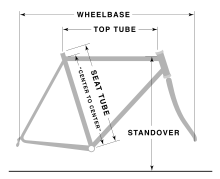Track bicycle
This article needs additional citations for verification. (June 2009) |

A track bicycle or track bike is a bicycle optimized for racing at a velodrome or outdoor track. Unlike road bicycles, the track bike is a fixed-gear bicycle; thus, it has only a single gear ratio and has neither a freewheel nor brakes. Tires are narrow and inflated to high pressure to reduce rolling resistance.
History

This section needs expansion. You can help by adding to it. (September 2016) |
The first bicycle race is popularly held to have been a 1,200 meter race on the 31 May 1868 at the Parc de Saint-Cloud, Paris. It was won by expatriate Englishman James Moore who rode a wooden bicycle with iron tires.[1] The machine is now on display at the museum in Ely, Cambridgeshire, England.
The Union Cycliste Internationale was founded on 14 April 1900 by Belgium, the United States, France, Italy, and Switzerland to replace the International Cycling Association, which had been formed in 1892, over a row with Great Britain as well as because of other issues.
Frame design
A track frame is specific to its intended use, with emphasis on rigidity and lightness. Frames for sprinting seek to maximize rigidity, while those for general racing seek to reduce aerodynamic drag. The dropouts or track ends face rearwards to facilitate chain tension adjustment. A true track fork, unless aerodynamics are the primary consideration, has round-section blades for greater lateral stiffness when sprinting. The crown is sometimes drilled to give the option of mounting a front brake when the bike is used on the road.
Rules
The governing body, the Union Cycliste Internationale (UCI), sets limits on design and dimensions as well as the shape and diameter of the tubes used to construct the frame. The UCI permits special exceptions for the construction and geometry of track bikes.[2]
A Keirin bike is a track bike for Keirin races in Japan that meets the strict system of standards of the JKA Foundation (Japan Keirin Autorace Foundation), the governing body for Keirin competitions, still popular under the abbreviation of its predecessor body - NJS (Nihon Jitensha Shinkōkai or the Japanese Bicycle Association).
Geometry

A track bicycle frameset differs from one used on the road by having:
- higher bottom bracket so the pedals do not touch a steeply banked track
- shorter chainstays
- steeper seat tube angle for a more aerodynamic position
- longer reach
- very tight clearances between wheels and frame tubes
- modern track frames use 120 mm (4.72 in) spacing for the rear hub
- some small-size track frames often have substantial toe overlap with the front wheel that is not an issue for velodrome riding but can make slow-speed turns awkward if the bike is used on the road.[3][4][5]
Material
Frames are assembled from tubular elements (typically with round or elliptical cross sections), or cast in a mould for "one-piece" type models. The most popular materials for frame building include steel, aluminium, or titanium alloys, carbon fiber, or a combination of these materials. Carbon fiber frames are most common at the professional level.[6]
Gear ratio
Track bicycles have only one drive sprocket (or cog) and one chainring, so the size ratio is relevant. A lower gear ratio allows quicker acceleration or 'jump' but can limit top speed. A larger gear ratio makes sustained speed easier, important in pursuit racing, time trial and bunched races such as points or scratch events. Without a good jump, the rider risks opponents accelerating away; without good sustained speed, the rider will be unable to keep up with a fast race. Track sprinters make a compromise by using particular gear ratios that allows them to reach race speeds at a relatively high cadence (pedalling), around 130-135 revolutions per minute (r/min).[7]
Long-distance attempts such as the hour record sometimes use high gear combinations such as 52×12 or 55×14. Ondřej Sosenka used 54×13 with 190 mm cranks to set the 2005 record.
Chain
Bicycle chains used in track, fixed gear and single speed cycling come in two common roller widths (the internal width between the inner plates), which is either 2.38 mm (3⁄32 in) or 3.18 mm (1⁄8 in). The chainring, sprocket and chain should all be the same width. Although a wider chain will work on a narrower chainring or sprocket, it is not ideal. A narrower chain will not work on a wider chainring or sprocket. Newer bicycles with derailleur gears use bushingless 2.38 mm (3⁄32 in) chains which flex, making gear changing possible. There are also 3.2 mm (1⁄8 in) bushingless chains on the market, which can be lighter or cheaper. Track bicycles, however, need increased strength rather than a lightness or a flexibility, so most of the track chains still use the full-bushing design.
Tires
Tubular tires are most often used in track racing and training, though advances in clincher tire design have seen them being used somewhat more often.[6]
See also
References
- ^ Maso, B (2005). The sweat of the gods: myths and legends of bicycle racing. Norwich, England: Mousehold Press. pp. 1–2. ISBN 1-874739-37-4.
- ^ "Approval Protocol for Frames and Forks" (PDF). Union Cycliste Internationale. p. 8.
- ^ "Look Cycle – Look T20 Speed Version". Look Cycle. Retrieved 20 February 2020.
- ^ "Cicli Pinarello – Pinarello MAAT 60.1". Pinarello. Retrieved 20 February 2020.
- ^ "Cicli Pinarello – Pinarello Dogma F12". Pinarello. Retrieved 1 March 2020.
- ^ a b "2019 World Championship Winning Equipment". Velodrome Shop. Retrieved 20 February 2020.
- ^ "Track Sprinting - a Question on Watts?". Union Cycliste Internationale. Retrieved 22 February 2020.
